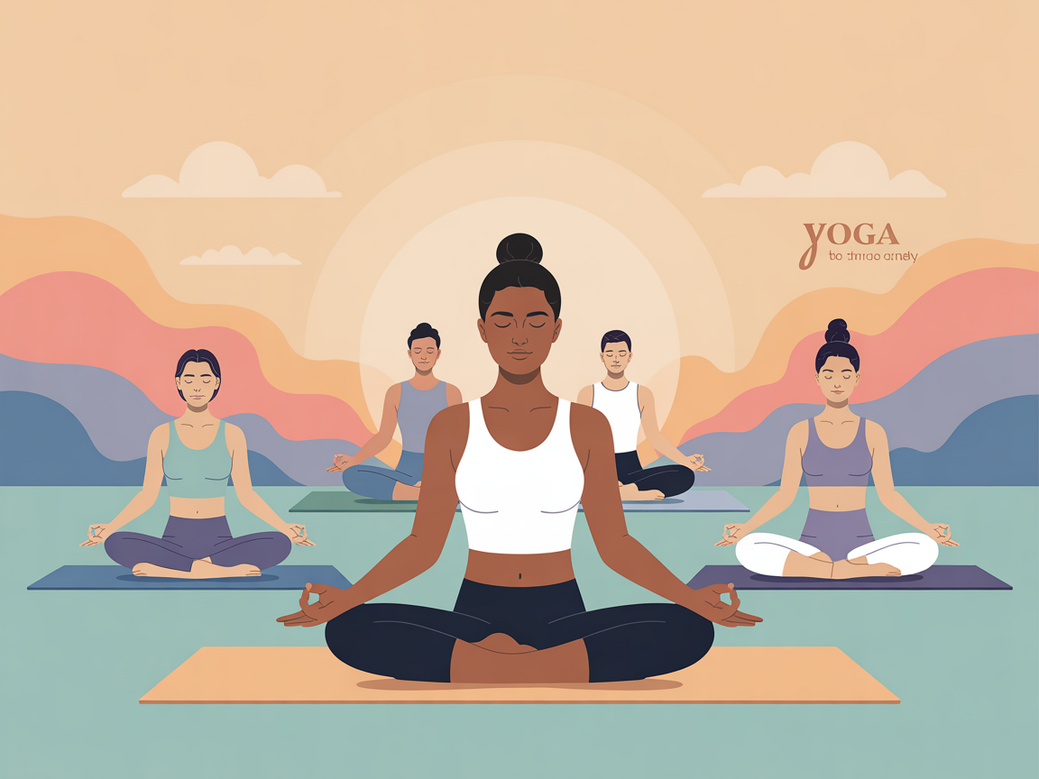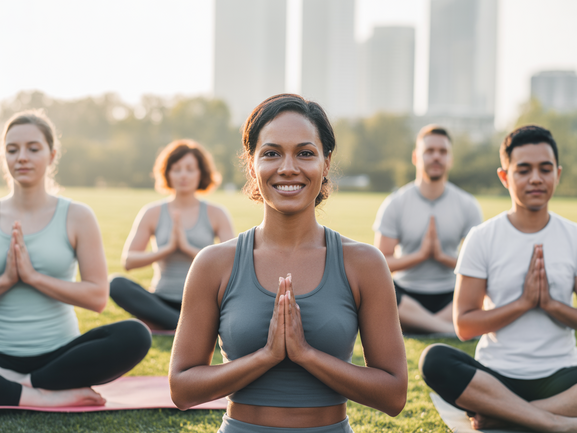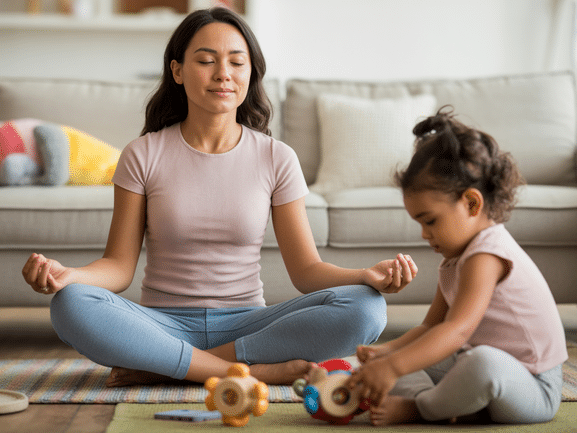How to Use Yoga for Anxiety Relief: A Practical Guide for 2025
Yoga for anxiety is a proven practice that merges physical postures, controlled breathing, and mindfulness to help regulate the body’s stress response system. It acts as a powerful tool to calm a racing mind, release accumulated physical tension, and cultivate a profound sense of inner peace. This approach isn’t about achieving flawless poses, but about fostering a meaningful dialogue between your mind and body to manage anxiety symptoms effectively and sustainably.
Have you ever wondered how some people maintain their composure amidst chaos? The answer often lies in a consistent, mindful practice. For Luzia, co-founder of Vitalizen, yoga was the key to navigating her own struggles with anxiety. Her transformative journey from personal challenge to becoming an international yoga instructor ignited a mission: to make mental wellness accessible to everyone, everywhere.

The Science Behind Yoga for Anxiety: How Does It Work?
To grasp how yoga for anxiety delivers results, it’s crucial to understand the science. Anxiety often activates the sympathetic nervous system, triggering the “fight-or-flight” response and flooding your body with stress hormones like cortisol and adrenaline. Yoga masterfully counteracts this by stimulating the parasympathetic nervous system—the “rest-and-digest” system. This physiological shift helps lower your heart rate, reduce blood pressure, and bring your mind to a state of calm.
According to research from Harvard Medical School, practices like yoga are effective because they stimulate the vagus nerve, a critical component of the mind-body connection. A well-toned vagus nerve is directly linked to improved mood, lower anxiety, and greater resilience to stress. Further studies, including a 2025 report from the National Center for Complementary and Integrative Health (.gov), confirm that consistent yoga practice can significantly reduce the severity of anxiety symptoms.
Core Components of an Effective Yoga Practice for Anxiety
Yoga employs several powerful techniques that work synergistically to alleviate anxiety. Each element plays a specific role in calming your nervous system and enhancing your mental state.
- Controlled Breathing (Pranayama): Deep, intentional breathing is a direct signal to your brain that it’s safe to relax. Simple actions like elongating your exhale can immediately diminish feelings of panic and stress.
- Mindful Movement (Asanas): The physical postures in yoga are designed to release tension stored in the body, especially in common areas like the shoulders, neck, and hips. This physical release often triggers a corresponding mental and emotional release.
- Mindfulness and Meditation: By anchoring your focus on the present moment—your breath, the sensations in your body—you train your mind to break free from destructive cycles of worry about the past or future.
Key Benefits of Using Yoga for Anxiety Management
Integrating yoga into your daily routine offers tangible and measurable benefits for your mental well-being. It is a holistic practice that addresses both the psychological and physiological symptoms of anxiety, making it a long-term management strategy rather than just a temporary fix.
Reduced Physiological Stress Response
One of the most immediate benefits is the reduction in the body’s stress markers. Consistent practice lowers cortisol levels and slows a rapid heart rate, leading to fewer feelings of panic and overwhelm in daily life.
Improved Sleep Quality
Anxiety and insomnia often go hand-in-hand. Yoga helps calm the nervous system, making it easier to fall asleep and stay asleep. Better sleep, in turn, leads to improved mood, enhanced cognitive function, and greater emotional stability.
Increased Mindfulness and Presence
This practice enhances your ability to stay grounded in the present moment. This leads to less rumination and worry about things outside of your control, fostering a greater sense of peace and acceptance.
How to Start Your Yoga for Anxiety Journey Today
Starting with yoga for anxiety doesn’t need to be intimidating. You don’t need to be flexible, strong, or have any prior experience. The only requirement is to show up for yourself with an open and curious mind. Here is a simple, step-by-step guide to begin your practice.
- Create a Calm Space: Designate a quiet corner in your home where you won’t be disturbed. All you need is enough space for a yoga mat to create your personal sanctuary.
- Choose a Guided Session: Begin with a beginner-friendly guided class. An app like Vitalizen offers sessions specifically designed for anxiety relief by qualified teachers like Luzia.
- Anchor Yourself with Breath: Before you start moving, sit comfortably and take five deep breaths. Inhale through your nose for a count of four and exhale slowly for a count of six. This simple exercise is your anchor to the present moment.
- Practice Gentle, Calming Poses: Begin with simple, restorative poses. Don’t push yourself; the goal is to feel a gentle release, not to force a shape.
- Embrace Consistency Over Perfection: Aim for just 10-15 minutes each day. Consistency is far more impactful than duration, especially when you are building a new, positive habit.
💡 Tip: “I never thought an app could make a difference. But Luzia’s calming voice and the beginner-friendly sessions helped me through my most anxious days. It felt like I had a teacher right there with me.” – A Vitalizen User
5 Simple Yoga Poses for Anxiety Relief
Here are five foundational poses known for their calming effects. Hold each pose for 5-10 deep breaths, focusing on the sensation of release.
1. Child’s Pose (Balasana)
This gentle forward bend calms the brain and relieves stress. It’s a resting pose that encourages you to turn inward. Kneel on the floor, touch your big toes together, and sit on your heels. Separate your knees about as wide as your hips, then fold forward, resting your torso between your thighs.
2. Cat-Cow Stretch (Marjaryasana-Bitilasana)
This dynamic movement links breath with motion, which is excellent for a wandering mind. Start on your hands and knees. As you inhale (Cow), drop your belly and look up. As you exhale (Cat), round your spine and press the floor away.
3. Legs-Up-The-Wall Pose (Viparita Karani)
An incredibly restorative pose that helps calm the nervous system. Sit with one hip against a wall, then swing your legs up the wall as you lie back. Your body should form an ‘L’ shape. Rest your arms by your sides, palms up.
4. Standing Forward Bend (Uttanasana)
This pose releases tension in the spine, neck, and back. Stand with your feet hip-width apart, exhale, and hinge at your hips to fold forward. Let your head hang heavy and gently shake it ‘yes’ and ‘no’ to release neck tension.
5. Corpse Pose (Savasana)
Perhaps the most important pose for anxiety. Lie flat on your back, with your feet falling open naturally and your arms resting by your sides, palms facing up. Close your eyes and allow your body to feel heavy and relaxed. Stay here for at least 5 minutes.
🎯 Ready to Find Your Calm?
Your journey to a more peaceful mind can begin right now. Let Luzia’s expert guidance support you. Download the Vitalizen app and discover the transformative power of yoga for anxiety.
Frequently Asked Questions (FAQ)
Can yoga really cure anxiety?
While yoga is not a “cure,” it is a highly effective practice for managing anxiety. Numerous studies show that a consistent yoga practice helps reduce the body’s stress response, lowers heart rate, and encourages mindfulness. A 2025 report from the National Center for Complementary and Integrative Health (.gov source) confirms its significant benefits for mental health and stress reduction.
How much does yoga for anxiety cost?
The cost can vary widely. In-person studio classes typically range from $20-$30 per session. However, digital options provide a much more affordable alternative. Many apps offer free introductory content, while a subscription to a specialized app like Vitalizen can cost as little as $10-15 per month, providing unlimited access to expert-led classes focused on anxiety relief.
Is online yoga as effective as in-person classes for anxiety?
For many people, yes! Online yoga offers unparalleled flexibility and the comfort of practicing in a safe, private space, which can be especially beneficial when dealing with anxiety. With an app like Vitalizen, you receive high-quality instruction from an expert like Luzia, ensuring you are guided safely and effectively. This makes it a powerful and convenient alternative to in-person classes.
How does Vitalizen differ from other meditation or yoga apps?
Vitalizen stands out because it is built on the real-world, international teaching experience of its co-founder, Luzia. It’s not just a library of generic content; it’s a curated yoga therapy program specifically focused on anxiety. We combine authentic, time-tested yoga practices with the convenience of a modern meditation app for a uniquely personal and effective experience.
What makes Luzia qualified to teach anxiety-focused yoga?
Luzia’s qualification stems from a powerful combination of over 10 years of professional teaching across different countries and her own personal journey of overcoming anxiety through yoga. This dual experience provides her with deep empathy and a practical, real-world understanding of what truly works for anxiety management.
For more tips on using mindfulness practices like yoga for anxiety, be sure to check out our other articles on the blog or contact us with your questions!


